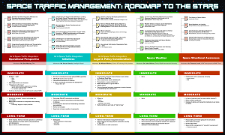Start Date
12-11-2015 3:15 PM
Abstract
With increasing commercial space activities occurring in the National Airspace System, the FAA has identified a need for more efficient management of the NAS with respect to commercial space operations. Current methods for integration of aviation and space activities employ a segregation approach, in which hazard areas are constructed around launch and reentry operations and sections of airspace are closed to other users. Mission objectives and vehicle characteristics dictate the extent of the closure in terms of location, duration, and volume of airspace affected. Launches, reentries, and other operations have an effect on other NAS stakeholders, causing delays, changes to airlines’ flight plans, and incurred expenses from additional fuel burn caused by reroutes. Likewise, attempts to minimize these effects can be detrimental to launch and reentry operators, leading to additional costs in delays and lost opportunities for mission success. There is opportunity to improve efficiency and increase NAS capacity. Hazard areas and airspace closures can be managed to reduce the effects on other NAS users, and in turn, provide more launch opportunities. In addition to managing the NAS more efficiently, potential for human error can be reduced by replacing manual processes with an automated approach. The paper will discuss the development and testing of the FAA’s Space Data Integrator system as it aims to improve current NAS integration by automating situational awareness, providing better monitoring of vehicles traveling through the NAS, and enhancing the ability to detect and respond to off-nominal scenarios.
Area of Interest
NAS Integration
Improving the Integration of Launch and Reentry Operations into the National Airspace System
With increasing commercial space activities occurring in the National Airspace System, the FAA has identified a need for more efficient management of the NAS with respect to commercial space operations. Current methods for integration of aviation and space activities employ a segregation approach, in which hazard areas are constructed around launch and reentry operations and sections of airspace are closed to other users. Mission objectives and vehicle characteristics dictate the extent of the closure in terms of location, duration, and volume of airspace affected. Launches, reentries, and other operations have an effect on other NAS stakeholders, causing delays, changes to airlines’ flight plans, and incurred expenses from additional fuel burn caused by reroutes. Likewise, attempts to minimize these effects can be detrimental to launch and reentry operators, leading to additional costs in delays and lost opportunities for mission success. There is opportunity to improve efficiency and increase NAS capacity. Hazard areas and airspace closures can be managed to reduce the effects on other NAS users, and in turn, provide more launch opportunities. In addition to managing the NAS more efficiently, potential for human error can be reduced by replacing manual processes with an automated approach. The paper will discuss the development and testing of the FAA’s Space Data Integrator system as it aims to improve current NAS integration by automating situational awareness, providing better monitoring of vehicles traveling through the NAS, and enhancing the ability to detect and respond to off-nominal scenarios.




Comments
Gwen Mazzotta’s Bio
Dan Murray’s Bio